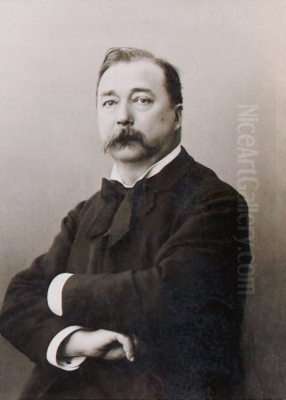
Jules Joseph Lefebvre stands as a significant figure in the landscape of 19th-century French art. Born on March 14, 1836, in Tournan-en-Brie, Seine-et-Marne, France, and passing away in Paris on February 24, 1911, Lefebvre carved a distinguished career primarily within the Academic tradition. He became renowned for his masterful portraits and, perhaps even more famously, his elegant and idealized depictions of the female nude. His work embodies the technical polish, refined aesthetics, and classical sensibilities favored by the official art institutions of his time, particularly the influential Paris Salon.
Lefebvre's journey from a provincial town to the heart of the Parisian art world is a testament to both his talent and the support he received. As a leading exponent of the Academic style, he garnered numerous accolades, including the prestigious Prix de Rome, and played a crucial role not only as a creator but also as a highly respected educator, shaping the skills of a generation of artists from France and abroad. His legacy is preserved through his numerous canvases housed in museums worldwide and his impact on the trajectory of figurative painting during a period of significant artistic change.
Early Life and Formative Years
Jules Joseph Lefebvre's origins were relatively humble. His father was a baker, a trade far removed from the artistic circles of Paris. However, recognizing his son's burgeoning talent and inclination towards art, Lefebvre's father supported his ambition to pursue painting. This crucial encouragement enabled the young Jules to move to Paris in 1852, the epicenter of the European art world, to formally begin his artistic training.
Upon arriving in Paris, Lefebvre sought instruction from established masters. He initially became a pupil of Léon Cogniet, a respected painter known for his historical scenes and portraits, and a prominent figure associated with the Neoclassical and Romantic movements. Under Cogniet's tutelage, Lefebvre honed his foundational skills. His dedication and aptitude quickly became apparent, leading to his admission into the prestigious École des Beaux-Arts, the official French national school of fine arts, just a year later in 1853. This institution was the bastion of Academic training, emphasizing rigorous drawing, study of classical antiquity, and mastery of composition.
The Path to Recognition: The Prix de Rome
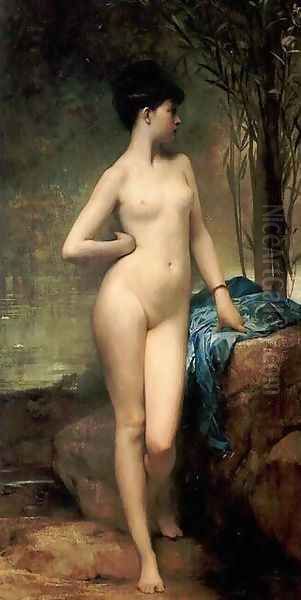
Lefebvre's time at the École des Beaux-Arts was marked by diligent study and participation in the established system of artistic competitions. He made his public debut at the Paris Salon, the official and highly influential annual art exhibition, in 1855. Consistent participation in the Salon was essential for any artist seeking recognition and patronage during this era. Lefebvre continued to exhibit regularly, gradually building his reputation.
A pivotal moment in his early career arrived in 1861. Competing for the highly coveted Prix de Rome, Lefebvre submitted his historical painting, The Death of Priam. This work, depicting a dramatic scene from Homer's Iliad, showcased his mastery of historical narrative, anatomical accuracy, and compositional skill, all hallmarks valued by the Academy. His painting secured him the first prize. Winning the Prix de Rome was a significant achievement, providing the recipient with a funded residency at the French Academy in Rome, located in the Villa Medici. This period allowed artists to study classical masterpieces firsthand, further solidifying their Academic training and significantly boosting their future career prospects.
A Defining Shift: Embracing the Female Form
While Lefebvre's early success was rooted in historical painting, exemplified by his Prix de Rome-winning work, his artistic focus gradually evolved. Following his time in Rome, and perhaps influenced by personal experiences, including the loss of his parents and sister during his residency, his work began to show a shift. While he continued to produce portraits and occasional historical or allegorical scenes, he became increasingly known for his depictions of the female figure, particularly nudes.
A key turning point occurred in 1868 with his painting Reclining Nude (Femme Couchée). Exhibited at the Paris Salon, the work garnered considerable attention and critical acclaim for its technical finesse and sensual beauty, despite some expert criticism regarding its boldness. Its success was significant, contributing to Lefebvre being awarded the Chevalier de la Légion d'Honneur, one of France's highest honors, that same year. This painting solidified his reputation as a master of the female form and marked a definitive move towards the subject matter that would dominate much of his subsequent career. He found a receptive audience for these elegant, idealized, yet often subtly sensual portrayals of women.
Masterpieces of the Human Figure
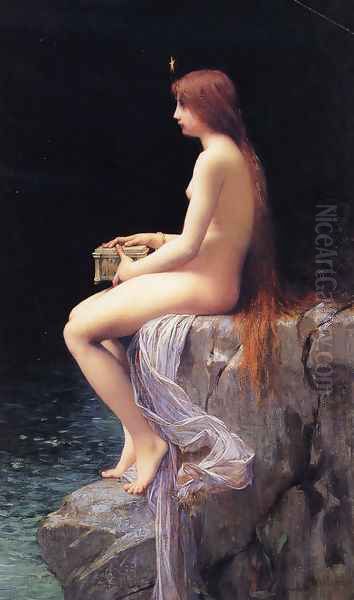
Lefebvre's oeuvre is rich with celebrated depictions of female subjects, both nude and clothed, often drawing inspiration from mythology, allegory, or simply celebrating idealized beauty. Among his most famous works is La Vérité (Truth), painted in 1870. This striking allegorical nude, depicting a woman holding a mirror aloft, is considered one of his masterpieces and resides in the Musée d'Orsay in Paris. The painting's powerful composition and symbolic resonance have led some to suggest it as a possible influence on Frédéric Auguste Bartholdi's design for the Statue of Liberty, though this remains speculative. La Vérité exemplifies Lefebvre's ability to blend classical form with a certain romantic sensibility.
Another iconic work is Chloé, painted in 1875. This particular nude gained immense popularity, especially after being displayed in Melbourne, Australia, where it became a cultural touchstone. Its delicate rendering and the perceived innocence of the model captured the public imagination. Other notable works exploring the female form include Undine (1881), inspired by mythological water spirits and showcasing his skill in rendering textures like flowing hair and water; Pandora (1877), a classical theme revisited with his characteristic elegance; Diana (1879), portraying the Roman goddess of the hunt; and the Odalisque (1880), engaging with the popular Orientalist themes of the time. These works consistently demonstrate his refined technique, smooth finish, and focus on graceful lines.
Portraiture: Capturing Likeness and Status
Alongside his celebrated nudes and allegorical figures, Jules Joseph Lefebvre was a highly sought-after portrait painter. His skill in capturing a likeness while adhering to the Academic standards of elegance and finish made him popular among the French elite and international clientele. His portraits often convey a sense of dignity and composure, reflecting the status of his sitters.
Notable examples of his portraiture include the painting of M. L. Reynaud and the portrait of The Imperial Prince (Napoléon, Prince Imperial), completed in 1874. These works demonstrate his ability to render textures, such as fabrics and flesh tones, with meticulous detail. While perhaps less overtly sensual than his nudes, his portraits still showcase his mastery of drawing and his ability to create a polished, idealized representation of his subjects, fulfilling the expectations of Academic portraiture in the late 19th century. His success in this genre further cemented his position within the official art establishment.
Lefebvre's Artistic Style: The Academic Ideal
Jules Joseph Lefebvre's artistic style is firmly rooted in the French Academic tradition of the 19th century. This approach emphasized meticulous draftsmanship, a smooth, highly finished paint surface that concealed brushstrokes, idealized forms derived from classical sculpture, and carefully structured compositions. His figures, particularly his female nudes, are characterized by graceful contours, flawless skin, and often a serene or subtly melancholic expression. There is a clear lineage back to the Neoclassicism of artists like Jean-Auguste-Dominique Ingres, particularly in the emphasis on line and idealized form.
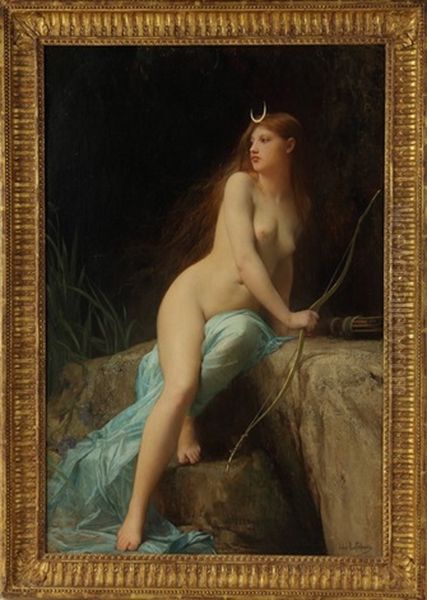
While fundamentally Academic, Lefebvre's work sometimes incorporates elements of Romanticism, especially in the choice of mythological or allegorical subjects that allow for emotional expression, albeit restrained. His handling of light is typically soft and diffused, modeling forms gently rather than creating harsh contrasts. The color palettes are often harmonious and controlled. He excelled in rendering different textures, from luminous skin to flowing hair and rich fabrics. Beyond easel painting, Lefebvre also undertook decorative commissions, including murals for public buildings like the Paris law courts (Palais de Justice) and the Hôtel de Ville (City Hall), demonstrating his versatility within the Academic framework. His style represented the pinnacle of official taste before the rise of Impressionism and subsequent modernist movements challenged its dominance.
A Respected Educator: The Académie Julian
Beyond his own artistic output, Lefebvre made significant contributions to art education. He was a prominent and highly respected professor at the Académie Julian in Paris. This private art school, founded by Rodolphe Julian, was a crucial alternative and supplement to the official École des Beaux-Arts, particularly notable for accepting female students long before the École did. Lefebvre, along with other prominent artists like Gustave Boulanger and later William-Adolphe Bouguereau, formed the backbone of its teaching staff.
Lefebvre was known for being an excellent and sympathetic teacher. He emphasized the fundamental importance of drawing, particularly drawing from the live model, as the basis of all figurative art. His pedagogy adhered to the Academic principles of rigorous training and technical mastery. He attracted a vast number of students, estimated to be over 1500 throughout his teaching career. Notably, a large contingent of these students came from the United States, seeking the prestige of Parisian training. His pupils included future prominent artists such as the Belgian Symbolist Fernand Khnopff, American Impressionists Childe Hassam, Edmund C. Tarbell, Frank Weston Benson, and John Henry Twachtman, as well as Kenyon Cox, Thomas Wilmer Dewing, Robert Henri (who would become an influential teacher himself), the British painter William Hart, the German-Baltic artist Ernst Friedrich von Liphart, and French painters like Georges Rochegrosse and Félix Vallotton. His influence as an educator extended far beyond France.
Navigating the Art World: Contemporaries and Competition
Lefebvre operated within the highly structured and competitive art world of late 19th-century Paris. The Paris Salon was the primary venue for artists to gain exposure, secure commissions, and achieve official recognition. Lefebvre was a stalwart of the Salon, exhibiting an impressive total of 72 paintings there between 1855 and 1898. His consistent presence and the frequent acclaim his works received solidified his status within the establishment.
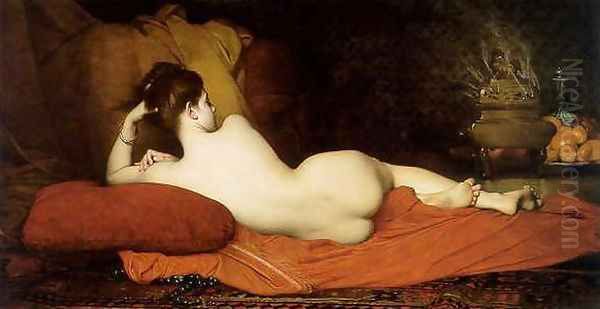
His primary competitor, particularly in the popular genre of the female nude, was William-Adolphe Bouguereau. Both artists were masters of Academic technique and achieved immense popularity, yet subtle differences existed. Bouguereau's work often leaned more heavily towards mythological and pastoral scenes with a sometimes more sentimental or overtly idealized quality, while Lefebvre's nudes could possess a slightly cooler classicism or a more direct, less allegorized presentation. Both artists, along with others like Jean-Léon Gérôme and Alexandre Cabanel, represented the dominant Academic taste that was increasingly being challenged by emerging avant-garde movements, most notably Impressionism, led by figures such as Claude Monet and Edgar Degas. Lefebvre remained firmly aligned with the Academic tradition throughout his career.
Personal Trials and Later Years
Despite his professional success, Lefebvre's life was not without personal hardship. During his time studying in Rome after winning the Prix de Rome, he faced significant family tragedy, losing both his parents and a sister. Later in life, he experienced further sorrow when his wife suffered from mental illness, requiring institutionalization, and eventually passed away. These personal difficulties may have contributed to a perceived conservatism in his later work and a gradual reduction in the number of works he submitted to the Salon in his final years.
Nevertheless, official recognition continued. In 1891, he was elected as a member of the prestigious Académie des Beaux-Arts, one of the highest honors for a French artist, succeeding Émile Signol. His earlier award of Chevalier de la Légion d'Honneur in 1870 (often cited as 1868 following the success of Reclining Nude, though official records might vary or indicate promotion later) was a mark of significant state approval. He continued to paint and teach, remaining a respected figure in the Parisian art scene until his death in Paris in 1911 at the age of 74.
Legacy and Conclusion
Jules Joseph Lefebvre represents a high point of French Academic painting in the latter half of the 19th century. He was a master technician, renowned for his elegant portraits and, most notably, his idealized depictions of the female nude. Works like La Vérité, Chloé, and Reclining Nude secured his fame during his lifetime and remain key examples of the Academic style favored by the official Salon and its patrons. His adherence to classical principles, combined with a refined sensibility, made his work highly popular before tastes began to shift dramatically with the advent of modernism.
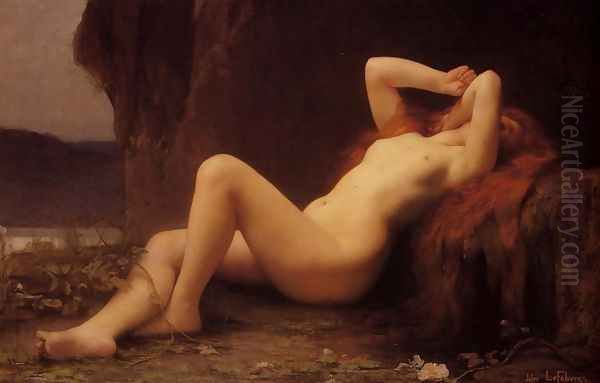
While the Academic tradition he championed fell out of critical favor for much of the 20th century, there has been a renewed appreciation for the technical skill and aesthetic qualities of painters like Lefebvre. His significant role as an influential educator at the Académie Julian, shaping generations of artists from Europe and America, including many who would go on to participate in Impressionism and other movements, adds another important dimension to his legacy. His paintings continue to be held in major museum collections, including the Musée d'Orsay, offering insight into the official artistic culture of France during a pivotal era of change and ensuring his place in the annals of art history.